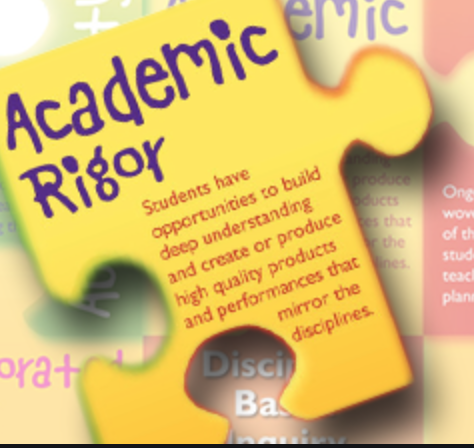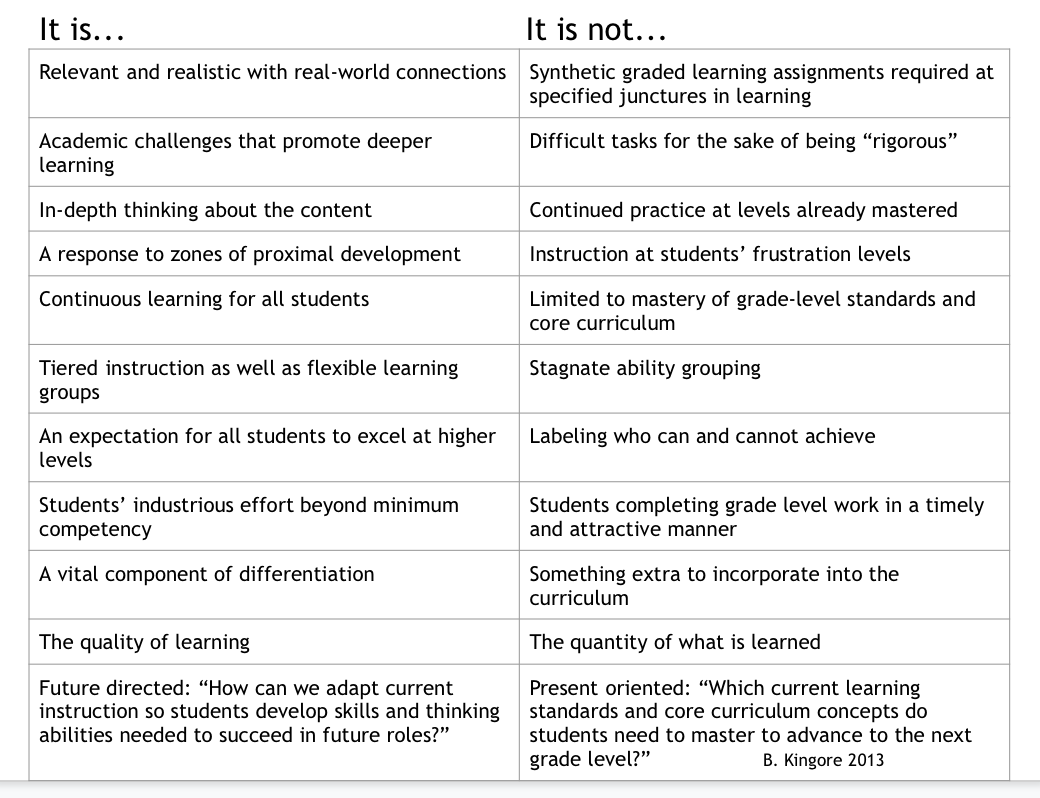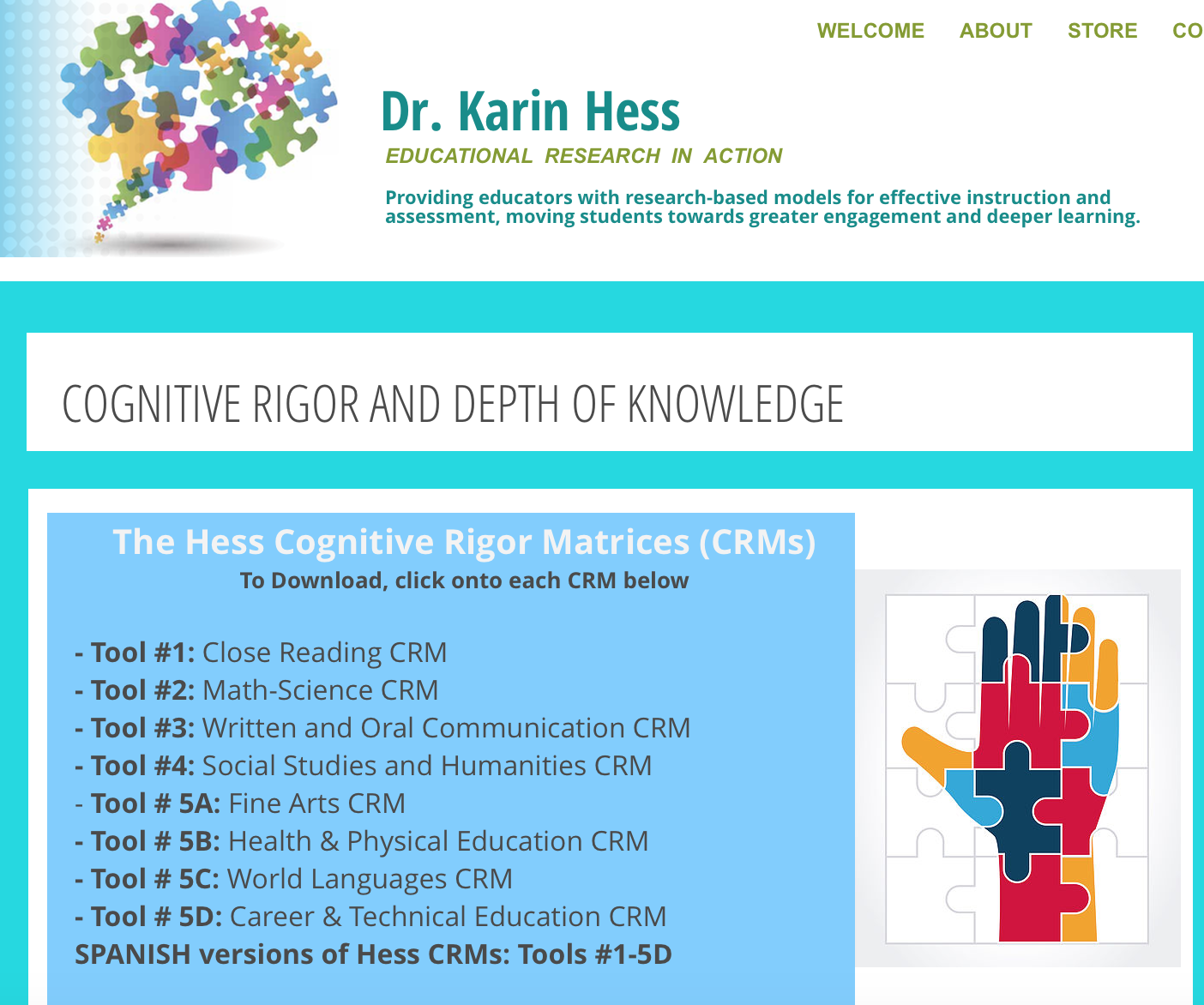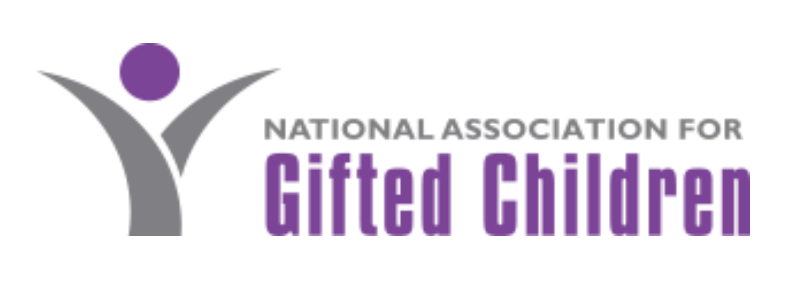Strategies to Support 2e Learners
| Site: | Colorado Education Learning Management System |
| Course: | 2e (Open Access) Supporting Twice Exceptional Learners |
| Book: | Strategies to Support 2e Learners |
| Printed by: | Guest user |
| Date: | Wednesday, 17 December 2025, 4:43 AM |
Description
Add content into this book. Differentiation! Depth & Complexity. Betts, Renzulli and other models of supporting giftedness. Keep it as a big picture and reference other GE courses. Balance the reality that this may be the only course participants take with it only being a 15 hour course and there are paths to go into more depth.
1. Universal Design for Learning
So often curriculum and instruction focuses on the average student or students who are in the middle. There is a better way! Watch this 3 minute video for an excellent metaphor on not planning ONLY for the middle:The 2e learner is on both of those sides (ok, physically impossible in bowling, but you get the idea, right?). What if planning for the students on the two ends, not the middle, helped all students? What if you also considered the cultures of the students as you were planning in the design of your instruction?
Universal Design for Learning (UDL) is an evidence-based approach that shows how to design curriculum and instruction to reach all learners. UDL is regarded so highly that it's mentioned by name in the nation's main education law. The Every Student Succeeds Act (ESSA) encourages states and districts to use federal funding to help teachers expand the use of UDL.
Watch this short (5 minute) video to learn more.
Simply put, UDL is a framework for how to develop lesson plans and assessments. It's based on three main principles: (Morin. Understood.org)
- Engagement: Look for ways to motivate learners and sustain their interest. Here are some examples:
- Let people make choices
- Give assignments that feel relevant to their lives
- Make skill building feel like a game
- Create opportunities for learners to get up and move around. Movement throughout the day supports our 3e learner needs as well by incorporating culturally responsive learning practices. (Boykin, 2011, Trotman Scott & Ford, 2013). It helps "flip the script" (Trotman Scott & Moss-Bouldin, 2014).
- Representation: Offer information in more than one format. For example, if the instructor provides a worksheet, make sure there are other options to demonstrate learning such as:
- Audio, which could be as simple as saying the written directions out loud
- Video showing how to solve one of the problems
- Experiential learning
- Gamification of task or content
- Action and Expression: Give learners more than one way to interact with the material and to show what they know. For example, they might get to choose between:
- Taking a pencil-and-paper test
- Giving an oral report
- Making a video, story board, or a comic strip
- Doing a group project
- Incorporate culturally relevant representations using their heritage (or native language to demonstrate mastery:
- Dance: step, ballet, folklorico, etc,
- Textile arts representation
- Composing a song
- Supplanting graphic arts project or written one
- Drama: creating a skit or puppet show
Culturally responsive education (CRE) is an approach to schooling that promotes student engagement, learning, and achievement by centering their knowledge, cultural backgrounds, and everyday experiences in the classroom. Students who experience CRE engage with academic content in ways that are personally meaningful, build purpose, counter stereotypes, and develop their ability to connect across lines of difference. Other common frameworks that describe this education philosophy include culturally relevant pedagogy, culturally responsive teaching, and culturally sustaining pedagogy (to learn more, see “Understanding Culturally Responsive Teaching”). By incorporating Culturally Responsive Gifted Education for 2e and 3e learners we can infuse the student's culture into the UDL framework to increase engagement to reach all learners.
Take a moment to open this website, Culturally Responsive Education Resources for Federal, State, and Local Stakeholders to see how you might use these ideas and lessons for all your students, including your 2e learners.
Optional Resources on UDL: (note this is not required reading)
- What is Universal Design for Learning (UDL)
- Understanding Students Who Are 2e
- UDL, 21st Century Learning, and the Impact of School Reform for Twice Exceptional Students
- The Netflixification of 2e Education
- The Balance Podcast: Antiracism and Universal Design for Learning With Andratesha Fritzgerald
2. Relationships, Relevance, and Rigor
Eric Jenson, the well-known author of Brain-Based Learning, notes in his book that the brain transfers learning to long-term memory when it connects with something relevant.
Students also "buy" from teachers who form respectful relationships with them and work to challenge them. Jenson says when the brain is not "buying" what you are "selling" the brain is not changing.
Neurological research tells us that the brain buys relationships, relevance, and rigor. With those three pieces in place the brain then learns, changes, and grows (the ultimate goal of school!). Forming relationships with students is part of creating a nurturing environment along with supporting students' affective needs. Relevance and rigor and are included within learning strategies. Part of the power of strength-based, interest-based learning is that relevance is built into these opportunities by the student's own motivation.
3. What is Rigor?
What is Rigor?
Things to remember as we begin to consider rigor for 2e students...
Their strengths vary
Their challenges vary
You need to get to know the child on a personal level
There are strategies for their gifts that will “sometimes” work
There are strategies for their challenges that will also “sometimes” work
The trick is finding what works for the individual child
Working to accommodate 2e students is not a one-size-fits all approach. There is not a recipe book. (We wish there were.)
So let's begin with defining what rigor is and is not:
Despite all the research, there are seven myths about rigor that are often heard. Let’s look at each, then turn our attention to the true meaning of rigor.
-
Lots of homework is a sign of rigor.
-
Rigor means doing more.
-
Rigor is not for everyone.
-
Providing support means lessening rigor.
-
Resources equal rigor.
-
Standards alone take care of rigor.
-
Rigor is just one more thing to do.
7 Myths About Rigor in the Classroom
What we also know about rigor is that it is....
For example: Compare and contrast the U.S. Civil War with a civil war in another country.
For example: How might the United States be different if the North hadn’t won the Civil War?
For example: How did the role of photography evolve during the Civil War and subsequent conflicts?
For example: Perhaps 20% of the soldiers who fought in the Civil War were 16 years old or younger. Why and how did they enlist, and how was their experience different from the older men who served?
For example: How did the abolition of slavery affect the subsequent Suffragette Movement?
For example: More than 150 years later, some say slavery still exists in parts of the United States. Do you agree with this statement? Support your answers with current examples.
Take a few minutes to review pages 57-70 in the Level 2 Twice Exceptional Handbook in which several strategies for rigor are addressed.
4. Strategies to Implement Rigor
One of the best ways to add rigor is to look at higher level thinking skills. Thinking skills need to be taught to students and once they become aware of the different levels of thinking, the results are amazing. The following are some ways to approach higher level thinking.
Bloom's Taxonomy
It might help to think about Bloom's in terms of the "what" for thinking. Many are familiar with Bloom's Taxonomy of Learning which has been around since 1956 and which underwent a revision by Anderson and Krathwohl in 2000.
Three of the most significant changes they made include:
- changing the names in the six categories from noun to verb forms
- rearranging them as shown in the chart below
- creating a processes and levels of knowledge matrix
The article Bloom's Taxonomy of Learning Domains provides background information on Bloom's Taxonomy.
Webb's Depth of Knowledge
Next, to further understand rigor, read through this Edutopia article about Using Webb's Depth of Knowledge to Increase Rigor.
This Depth of Knowledge Overview Chart is a good resource to save, It starts with DOK's 4 levels, but aligns them with Bloom's Taxonomy and provides: 1) levels of complexity, 2) key verbs that may clue level, and 3) evidence of Depth of Knowledge.
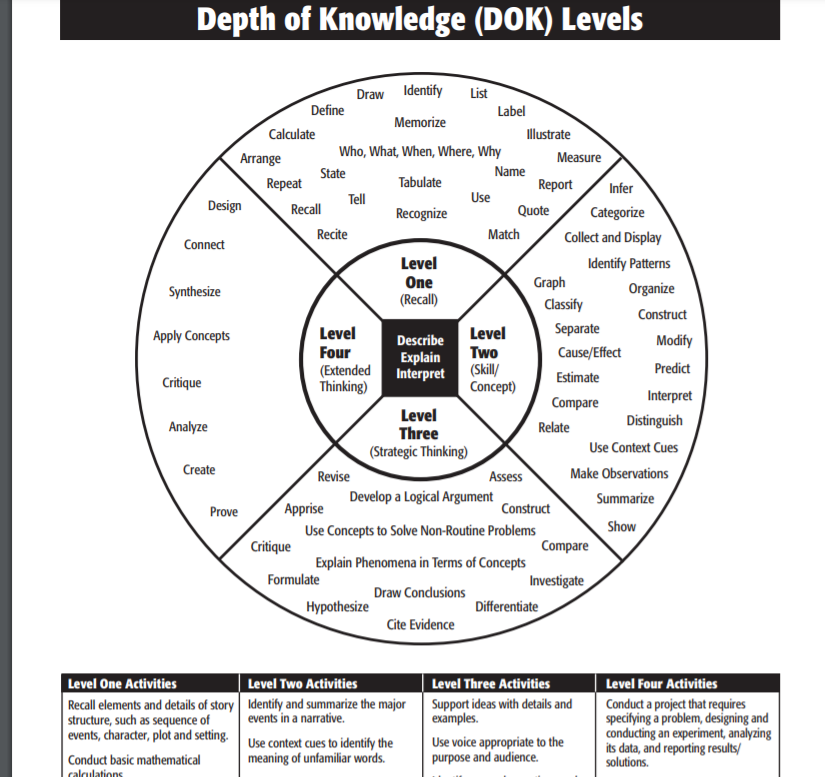
Depth and Complexity
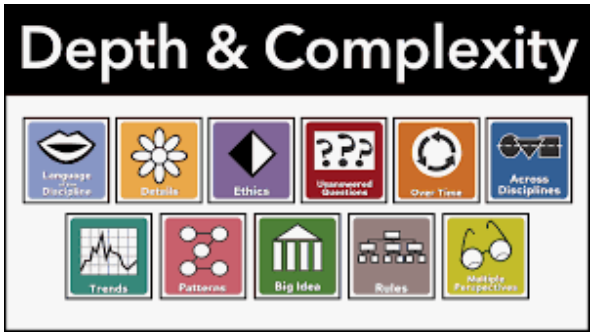
Another way to encourage high order thinking is by using the Depth and Complexity Framework which creates an inquiry-based classroom. This framework increases rigor in the classroom and student achievement by increasing higher level thinking. There are many districts who have offered training on Depth and Complexity, especially through their gifted education department, and there is a state level course offered twice a year through the Office of Gifted Education. We are presenting this here for you to seek more information about later if you are interested.
Ian Byrd's website Byrdseed provides resources on many topics concerning gifted students. In his article: Everything You Need to Know About Depth and Complexity Icons he provides a great overview and links to more in-depth information. Here is his description of the icons used in this framework (skim and save for later if you think you might use it).
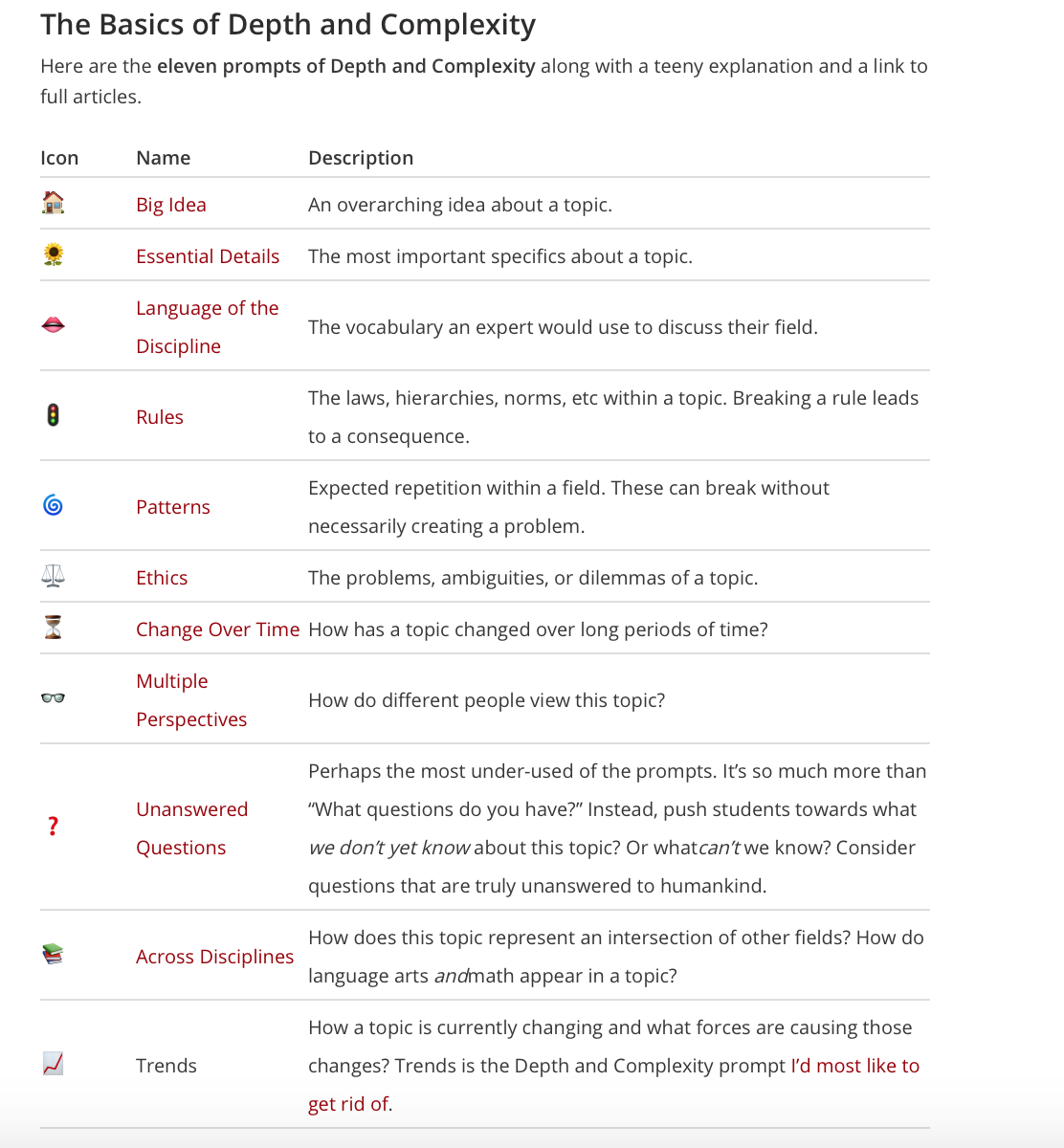
Everything You Need to Know About Depth and Complexity Icons
5. Supporting Rigor Using a Matrix
Another excellent resource for increasing rigor in the classroom is the work of Dr. Karin Hess.
Dr. Hess has created a series of Cognitive Rigor Matrices (CRMs) for many content areas where she has combined the work of Bloom and Webb. Her matrix incorporates:
-
Bloom – What type of thinking (verbs) is needed to complete a task?
-
Webb – How deeply do you have to understand the content to successfully interact with it? How complex or abstract is the content?
Take a few minutes to study a matrix that applies to your educational area. An example of the reading matrix is below, but other content areas can be found on her website: Cognitive Rigor and Depth of Knowledge.
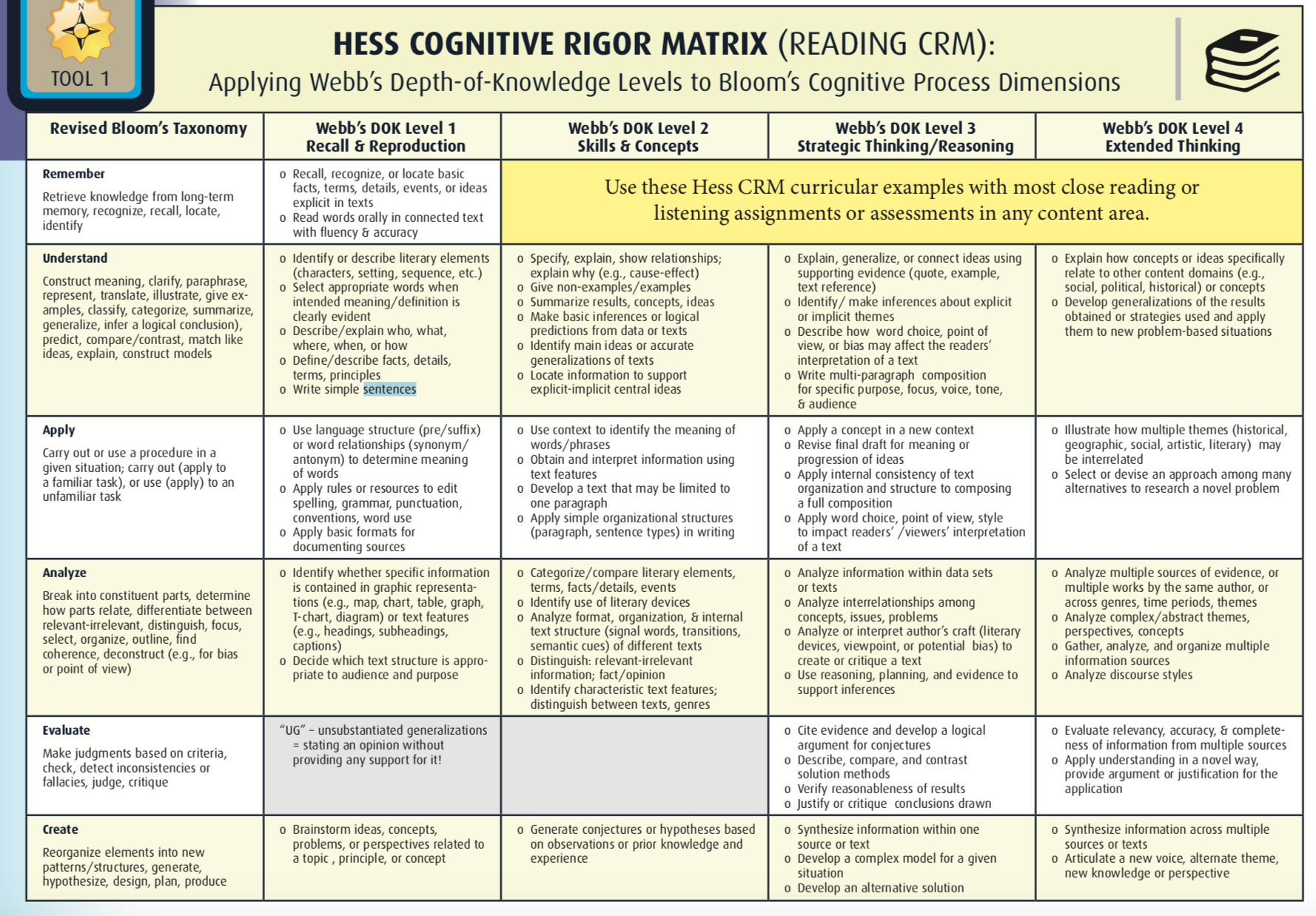
Hess Cognitive Rigor Matrix (Reading CRM)
Dr. Donna Ford has created a website that not only provides samples of different matrices, but also includes an article: Using the Blooms–Banks Matrix to Develop Multicultural Differentiated Lessons for Gifted Students Michelle Trotman Scott, PhD1. This provides another great way to incorporate relevant topics for our 2e students.
6. Early Intervention
All 2e experts agree that early intervention, provided at the first sign of difficulty without “wait to fail," is crucial for 2e learners. Resources can be pooled (e.g., Reading Recovery, Title I, and special education funds can be used to provide intense interventions). In this Part 1 of Supporting 2e Learners course, we are covering supporting the giftedness and strengths first. If you choose to take Part 2 of the course, you will go deeper into supporting gifted students with specific disabilities. For now, please remember that focus should be on students' needs and strengths - not just the disability.
Obviously, collaboration among educators and specialists is essential for early intervention because it brings together the needed perspectives and shared responsibilities. 2e students' needs are complex and diverse and it takes a team to develop a learning environment with both rigor and accommodations, and/or interventions. The composition of the team will vary depending on students' needs. For example, students on 504 plans, may need an interventionist as part of the team instead of a SpEd professional. There may also be a mentor who plays a key role in the student's life. The idea is to get the best picture of the student to support the learner.
For now, consider your case study student. Who needs to be involved in your educational setting in making decisions about your student?
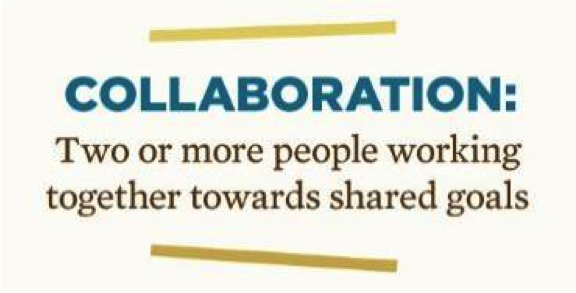
(Mary Ruth Coleman. 2004)
Meeting Diverse Needs: What Voices Might Need to Be Involved:
- Classroom teachers
- Gifted education and special education staff
- Mental Health Professionals
- Specialists in other health impairments
- Parents
- Students
- Community resources
We go further into collaboration in part 2 of the course.
In the end, the outcome should be success for the child.
7. Instruction and Training for Gifted Students from Diverse Populations
The National Association for Gifted Children (NAGC) published the following article which emphasizes the need for teacher training is this area. Please read this short but relevant article and also the articles included in the two links within this article: identification practices with diverse learners and best educational practices with low-income, high-ability students.
Four practices to promote equitable access and school success for underrepresented gifted students
- Develop culturally sensitive identification protocols
- Ensure early and continuous access to high-end curriculum for talent development
- Provide essential supports, including helping students develop psycho-social strategies
- Establish effective home, school and community connections
Download the full NAGC position statement on Identifying and Serving Culturally & Linguistically Diverse Gifted Students
Read more about identification practices with diverse learners.
Read best educational practices with low-income, high-ability students
Read Expanding the View of Giftedness in a special issue of AASA's School Administrator magazine.
Teacher Training
Because high ability and high achieving students are typically served in the regular classroom, it is critical that all teachers be trained to recognize and meet the needs of advanced students so that they may respond to individual student strengths and make referrals for further assessment where appropriate. It is also critical that school- or district-level staff with expertise in gifted and talented education be available to support regular classroom teachers in this work.
To develop the skills, identify advanced students from underserved populations and to create a learning environment that supports their needs, teachers and other school leaders need regular professional development that addresses the following
- Learning characteristics and behaviors of underrepresented gifted populations
- Awareness of cultural differences
- Children with multiple exceptionalities
- Developing positive peer culture in the classroom and school
- Equitable and nonbiased assessments
Explore gifted education practices that that have been shown to increase student achievement.
8. Strengths in the IEP or 504 Plans
When writing IEPs and 504 plans for 2e students, look for places to build-in a strength-focus. An the IEP/504 for a 2e student focused only on deficits will not be as effective and it may contribute to self-esteem issues and behavior problems.
If you look closely at the language in the Individuals with Disabilities Education Act (IDEA) you will find a few places that discuss the child’s strengths. The first is in the language regarding the development of the IEP where it states:
(A) In General. In developing a 2e student’s IEP, the IEP Team, shall consider:
- the strengths of the child;
- the concerns of the parents for enhancing the education of their child;
- the results of the initial evaluation or most recent evaluation of the child; and
- the academic, developmental, and functional needs of the child.
The second place is in the language regarding Transition Services where it defines these services to mean a coordinated set of activities for a child with a disability that is based on the individual child’s needs, taking into account the child’s strengths, preferences, and interests.
When you are beginning to identify and work with a 2e child the very first thing listed in IDEA under development of the IEP is to look at the strengths of the child. This is because the IEP will only work if you take into consideration the strengths of the child.
9. Technology
Assistive Technology device is any item, piece of equipment, or product system, whether acquired commercially off-the-shelf, modified, or customized that is used to increase, maintain, or improve the functional capabilities of a child with a disability (Technology-Related Assistance for Individuals with Disabilities Act of 1988 and IDEA 2004).
The following thoughts from experts in the field of twice-exceptional explain why it is critical that we integrate technology with learning for 2e students. Feel free to explore the links for more ideas on how to integrate technology -- optional.
"2e students use technology to enhance their lives — not only to compensate for what they may not be able to do, but more so to focus their attention on what they can do and to further explore areas of interest. Furthermore, technological aids, such as text-to-speech or organizational apps, enable 2e students to freely communicate their thinking in a way that suits their needs and, in turn, maximizes their learning and school experience" (Revealing the Strengths of 2e Students by Using Technology).
The rule to follow when teaching students who are twice exceptional is simple. When teaching in their areas of strength, offer them the same compacting and differentiation opportunities available to other gifted students. When teaching in their areas of challenge, teach them whatever strategies they need to increase their learning success. Never take time away from their strength areas to get more time to work on their deficiencies. Never remediate their weaknesses until you teach to their strengths! (Winebrenner, S., Strategies for Teaching Twice-Exceptional Students
Doobay and Croft from the Berlin-Blank Center suggest the following tools for reading, writing, math, and executive functioning disorders (NAGC, 2019)
Code: s = software, e = Chrome extension, t = tablet
READING
- Text Readers – Human, Audio Books, Snap & Read (e,s), Kurzweil (s,t), Read & Write (e,s,t), Select and Speak/Speak It! (e)
- Text Leveling – Rewordify (web), Snap & Read
- Reading Guides & Font – Signature Window, Beeline Reader (e,s,t), Open Dyslexic (e,s,t)
- Color – See It Right! Filters, colored paper, background/font
WRITING
- Low Tech Tools – writing tools and guides, highlighted paper
- Talking word processor, & spell checker – Clicker 7, Read & Write (s), CoWriter (s,e,t)
- Word Prediction – Co:Writer, Read & Write (s,e,t)
- Picture Support – Clicker 7 (s,t)
- Voice Input – Dragon Naturally Speaking (s), Voice Typing in Google Docs, Built in options
- Mind Maps – Post-its, Inspiration (s,t), Connected Mind (e)
- Note Taking – SmartPen, Notability (t), OneNote (s), Sonocent (s)
- Literacy Suites – Kurzweil (s,t), Read & Write (s,e,t), WYNN (s)
MATH
- Manipulatives: objects, Brain Camp Virtual (web)
- Visuals (Dot Cards, 100 board, patterns)
- Counting, + - X /, fractions, etc. apps (s,t)
- Talking, big button, layout calculators (s,t)
- Graph paper, Math Paper, ModMath (t)
- GeoGebra (web,e)
- EquatIO (e)
EXECUTIVE FUNCTIONING
Attention & Focus
- Auditory Stimulus: ear plugs, protective ear coverings, fan, fountain, calm sound, music
- Visual & Environment: Add Blocker. Readability (e), OneNote (to keep similar tabs, such as when doing research in one place)
- Movement, Seating: Balls with Feet, Disc’O’Sit, Inflatable Wedge
- Fidgets, Chewelry
- Timers – audio, visual, tactile, kinesthetic
Social Emotional Assistive Technology and Self-regulation Apps:
- Social Stories (low tech)
- Calm APP
- Headspace APP
- Self-Regulation and Technology-The Wave of the Future by Jeff Tran and Tina Mandal
Additional Considerations for Assistive Technology (AT):
- AT might be used in one environment but not another
- Both low and high tech AT may contribute to an effective intervention
- Assistive Technology won’t always be used (scaffold)
- Be careful of extra cognitive load
- Include the student in choosing AT
- Make sure there is training!! For student and staff!! And parents!!
(Bahr, P., Doobay, A., and Croft, L. NAGC 2019) Twice-exceptionality: Actualizing student potential through assistive technology.
Other Sources:
- Revealing Strengths of 2e Students Using Technology
- Did you know that iPhone, iPad, and iPod and almost all phones come with assistive technology built in?
